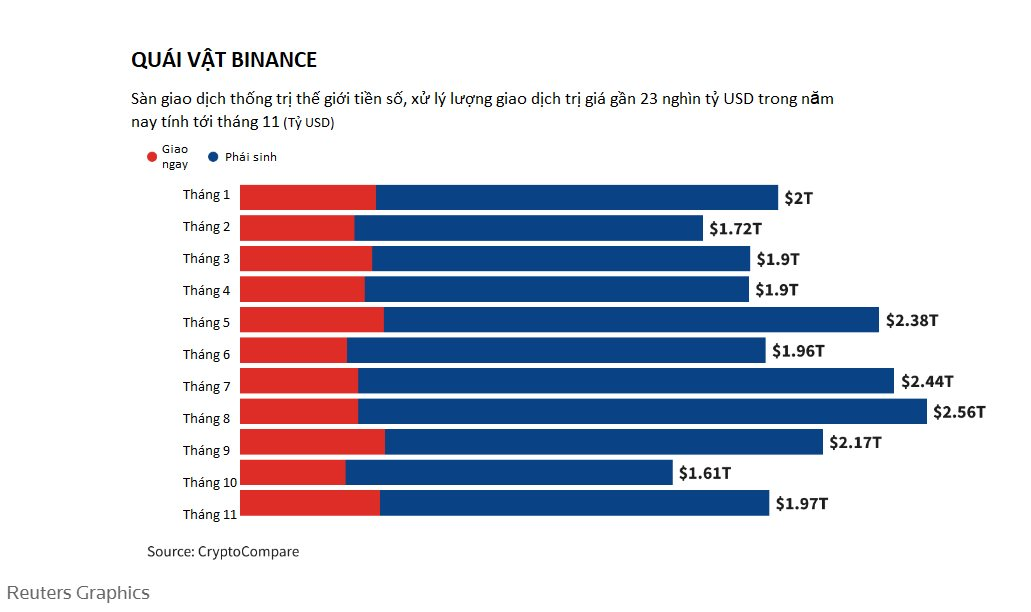Exclusive investigation on Binance: The mystery of the crypto exchange has no headquarters, financial information still attracts 120 million users, trading $ 22 trillion / year
- Tram Ho

Reuters has just published a special article, giving an analysis of the world’s largest cryptocurrency exchange Binance. Accordingly, Reuters has discovered that there are many mysteries surrounding Binance’s business.Here is part 1 of the translated article from Reuters.
The world’s largest cryptocurrency exchange Binance is fighting hard to build confidence in the company after a large number of customers withdrew from it. At the same time, the value of their digital currency also plummeted.
The exchange said that it coped well with a total withdrawal of up to 6 billion USD in 72 hours last week thanks to its solid financial position and also asserted that “we are responsible as a protector of customers”. serious goods”. Following the collapse of rival exchange FTX last month, Binance founder Changpeng Zhao has pledged his company will pioneer more transparency.
However, when Reuters experts analyzed Binance’s filings, they found that the company’s core business – Binance.com, which handles $22 trillion worth of transactions this year, is still the company’s core business. remains a mystery to the public.
Binance declined to make the headquarters of Binance.com public. They also do not disclose basic financial information such as sales, profits and cash reserves. The company has its own digital currency but did not disclose its role in the balance sheet. Binance also lends money to customers with their crypto assets as collateral and then executes margin trading. However, Binance did not detail these bets and how Binance responds to those risks or the amount of reserves they have to deal with customer withdrawals.
Of course, Binance does not necessarily disclose detailed financial information because they are not a public company like Coinbase. Binance also hasn’t raised outside capital since 2018 and that means it hasn’t had to share financial information with outside investors since.
In fact, Binance also actively avoids outside scrutiny. Founder Zhao approved a plan by aides to “isolate” Binance’s operations from US government scrutiny by setting up a separate American exchange. Zhao said that the branch was set up in consultation with leading law firms.

Binance’s pivotal role in the cryptocurrency market – which accounts for half of the industry’s trading volume – has made its activities the subject of concern for US authorities. The company is under investigation by the US Department of Justice for alleged money laundering and transaction violations. Reuters also reported this month that several prosecutors believe they have obtained clear evidence against Binance and its senior executives.
In an effort to review Binance’s accounting records, Reuters accessed Binance’s records at 14 locations it listed as having activity on the website and confirmed that they all had “licenses, registrations, authorized and approved in accordance with regulations”.
These locations include parts of Europe, Dubai and Canada. Zhao described the licenses as an important milestone in “Binance’s journey towards full licensing around the world.”
However, information from public records shows that these entities send very little information about Binance’s business to the authorities. The records also do not show the flow of funds between affiliates and main exchange Binance.com. Reuters experts found a series of branches barely functioning.
A former Binance executive said that local businesses only serve as tools to “beautify financial statements” for the main exchange, which is not licensed.
“They are wriggling to create a legal cover,” according to John Reed Stark – Former head of the SEC. Stark says that Binance’s operation is even more mysterious than FTX. “Obviously there is no transparency, no confirmation of any financial matters here.”
Binance’s chief strategy officer Patrick Hillmann said that Reuters’ analysis of the company’s local affiliates was “certainly wrong”. “The amount of financial and corporate information disclosed to authorities in those markets is enormous. We are a private company and do not have to disclose the financial position of the group,” he continued, comparing the exchange to other private US companies such as candy maker Mars. However, in a statement, Mars said it was “absurd” to compare its corporate governance and financial reporting requirements with those of Binance.
jigsaw pieces
The increase in withdrawals on Binance exchange last week was attributed by analysts to concerns about how cryptocurrency exchanges are holding users’ funds. The exchange has also stopped withdrawing some tokens. On Friday, Binance’s efforts to keep investors safe went up in flames when an accounting firm it hired to confirm the company’s reserves stopped working with all of its investors. all crypto companies.
There are only a few glimpses of Binance’s financial situation through Zhao’s public comments, previous company statements, blockchain data, and venture capital agreements.
Binance has said that it has 120 million users. Trading volume on Binance will total $34 trillion in 2021. Zhao said in an interview last month that “about 90%” of Binance’s revenue depends on cryptocurrency transactions. The company is profitable and “has a decent amount of cash reserves,” according to Zhao. Binance also made 150 venture investments, totaling $1.9 billion since 2018 according to PitchBook data. Zhao also created a $1 billion fund to invest in crypto companies that were struggling after the collapse of FTX.
In fact, reliable estimates of revenue based on Binace’s transactions are rare, even though trading volume data is public.
Binance charges a fee of 0.1% for spot transactions and applies a more complex fee structure to derivatives. With spot trading at around $4.6 trillion in the year to October, Reuters estimates that Binance could make as much as $4.6 billion in revenue. In addition, Binance will charge 0.04% fee for derivatives trading, which has a trading volume of $16 trillion and thus can generate $6.4 billion in revenue from the operation. this.
John Todaro, a senior analyst specializing in blockchain and cryptocurrencies, said that the above calculation by Reuters was “in the right range”. Binance’s advertisements for zero-trading or other rebates may result in slightly lower revenue.
Binance did not immediately respond to Reuters calculations. “Most of our revenue comes from trading fees,” said Hillmann, adding that the exchange can “accumulate large corporate reserves” by reducing costs. “Binance’s capital structure is debt-free,” and the company still separates the money it earns from fees from the assets it buys and holds from users.
Binance allows users to collateralize their crypto assets and borrow money to make derivative transactions up to 125 times the deposit value. For users, this can result in them making big profits or losing big. Hillmann said Binance supports all user deposits for derivatives and spot trading with its own reserves at a 1:1 ratio – meaning deposits will be safe and easy to withdraw.
He said that Binance has strict liquidation protocols in place to sell off users’ positions if their losses exceed the collateral value. If a user’s position becomes negative because of extreme market volatility, Binance will have very good capital insurance funds to cover the shortfall. Hillmann did not provide details and Reuters could not confirm these claims.
When asked about the size of any of the exchange’s losses this year, Hillmann said: “Binance’s risk department administers what are known as the industry’s best hedging schemes. This protects our users and our platform.”
Binance’s financial information is protected by Zhao – a Chinese Canadian. Zhao famously implemented a strict security culture throughout his leadership of Binance.
Even a source revealed that former Binance CFO Wei Zhou did not have access to all of the company’s financial statements during his three-year tenure. Zhou resigned last year and did not respond to requests for comment.
(To be continued)
Source: Reuters
Source : Genk
